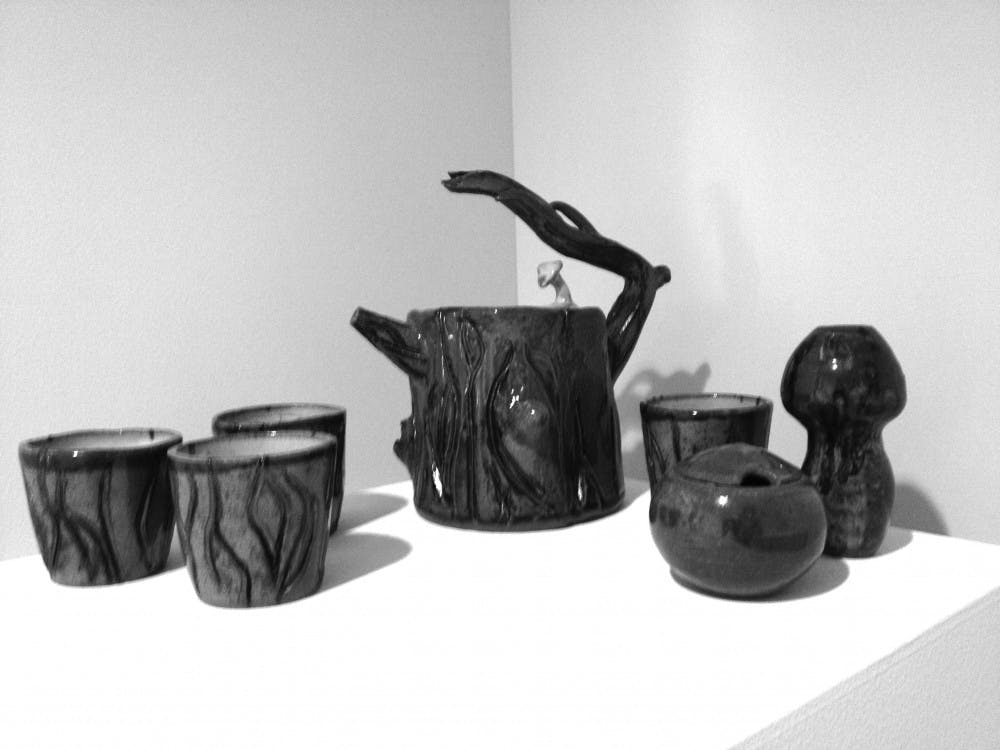Cyborgs have never been so inviting to get close to and stare at, even as their mysterious stillness can’t seem to last for long.
But that’s exactly what these sculptures are—hybrids of man and machine, lacking concrete definition or a place to call home. For now, they reside in Kauffman Gallery at Shippensburg University.
Other award-winning renditions line the square room, juxtaposing different moods against most of the hard or metallic sculptures. Liana Mosior most identifies with this motif in “No. 1, Section 5, Xinyi Road,” a portrait where a geometric conference center meshes with a girl’s complex psyche.
Despite the mixed media and subject matter, dominating the exhibit is a fusion between earthly and industrial elements using man-made materials.
It is the relationship between these two elements that varies in each figure.
In many of the pieces, open composition expresses the physical growth one sees in the natural world.
In “Metal Overtaking,” nature grows into industry as rusty leaves bind gears and cables, which twist upward, finally meeting the viewer at eye level.
This vine-like apparatus grows from a hollow square platform.
Like the other small or medium sculptures, Heather Latchford’s linear sculpture is displayed on a spotless white block.
The quirky structure called “None” threatens to fly away with its rusty wing as its tail-light eye possesses its viewer with a vacant stare. Colin Riley combines shiny bolts and rusty gears -—trinkets seen in the majority of these pieces.
Kayla Bennett reveals alcohol as a catalyst for sexual crimes in her work. “Poignant” is a blue and brown hued lady named for her fractured and hollowed body.
Viewers peered past her alluring skin into the huge holes in her chest and stomach. Her abdomen reveals what looks like partly-digested bottles, melted glass and plastic in a slow drip. She is one of the only pieces lacking metal.
Then there are sculptures that bring a smile. Resting in a corner, yet glimmering in the sunlight, is “Sometimes I Feel Like Cinderella,” a single slipper framework of what looks like aluminum and copper wire.
The windowed corner lights up Audrey Ketterer’s princess shoe, giving it the fantastical element her title suggests.
Ashly Sterner’s “Animal Print Tea Bowl” and Kayla Chambers’ “Oenanthe Crocata” comprise a woodsy tea set to redefine “refined dining.”
I can picture a nature-lover pouring cream from a stoneware mushroom into the bark-encrusted cups, then sipping tea from them. These three reconceptualized traditional, even formal, societal norms by naturalizing or metalizing something normally seen as delicate.
“Modern Trophy” by Hannah Kunce was another delight, maybe because it is so aptly recognized as a set of antlers.
These materials transform the antlers from a prideful triumph to a relic to be admired.
It appears the student exhibition backs up its bold claim of having “something for everyone.”
Together, these sculptures mirror the conflicting views of where humans stand in relation to the environment. Each form lies somewhere on a continuum of natural and synthetic.
We are these cyborgs, finding our place somewhere between culture and countryside.
Kauffman Gallery is located in the Huber Art Center and is open from 9 a.m. to 3 p.m., Monday through Friday. The student exhibit was on display from March 3 to 28. Some pieces are available for purchase.




The Slate welcomes thoughtful discussion on all of our stories, but please keep comments civil and on-topic. Read our full guidelines here.